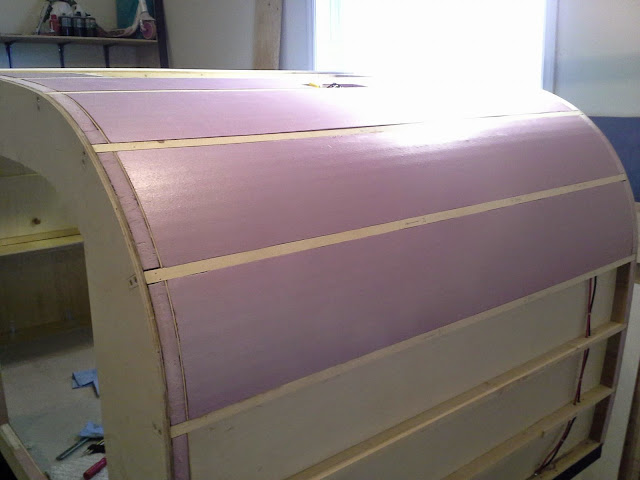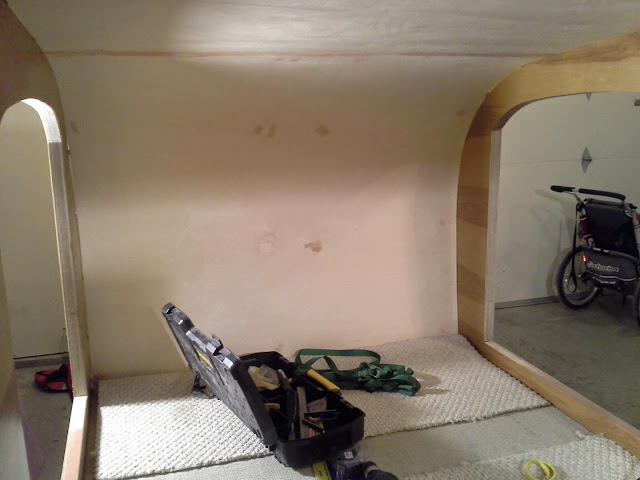So, to clarify, when they say, "get ready for lots of sanding", with projects like this, they mean LOTS of SANDING. Like, when you're expecting a child and they say you should expect to lose a little bit of sleep. Or when you're in World War I and they say, "it might be a little muddy."
So I exaggerate a little. Or do I?
Anywho, not too many photos this time. Why? Well, because the damn thing looks precisely like it has for weeks to months, only with varying amounts of plastic-y coating:
I'm getting the hang of epoxy just fine. It is tricky. The mixing and quantities are fine (if you can count and stir you can do that), and I haven't seen much amine blush (waxy coating produced during the cure). However, a couple of other things are non-simple:
- I got burned by cheap rollers on the first round with the doors. They lost a lot of fluff in the mix. That produced a lot of stippling and resulted in excessive sanding.
- Because this stuff is so transparent, it's easy to think you've just sanded it all off accidentally. I made that error, again with the outside of the doors. I washed the dust off (but not well enough), and thought I felt the wood knap underneath. In retrospect, it was likely the grainy plastic-dust I was feeling. I've since sanded through the epoxy in other areas, and it's obvious.
- There are a lot of dips and drips. It's tough to get it totally even. My preferred method is to apply with a roller, then "tip" with a soft brush. I tried applying with a drywall knife, but it wasn't as easy. Even when applied evenly, it sags a lot, particularly on vertical surfaces. This makes for more sanding, but the results are still excellent in the end.
- Speaking of sanding, the old random orbital sander works well for finishing things off, but it's surprisingly slow on the smooth shiny plastic that we start with. My current solution is to do the bulk of the work with a hand sanding block, which is way faster, and finish with the ROS. Good results.
- If you want to wrap the fibreglass around a corner, you need to do it at the same time as the main portion. I waited with the hatch, and it got crusty and wouldn't bend. I wound up cutting it off. Not a big deal -- the joint should be quite strong without, and it'll get aluminium trim eventually anyhow.
So, all that said, here's the summary of progress:
- The hatch and the doors are mostly done, inside and out. The hatch got glass on the outside only. There are a couple of spots to fill, but these are 98% done.
- The epic glass and sanding job is done on the roof! The wrap-around on the walls still needs to be sanded, as does the hatch hole, and the fibreglass join area will need a little filling. As a rough gauge, this took about 4 part-days of sanding! Part days because I thought my arms might fall off otherwise. Sanding gets tougher as the surface gets flatter, which makes me think I need a smaller sanding block.
- The walls and door frames still need to be done. That should be simple compared to all the glass I've already put behind me.
I'm worried that the epoxy is going to cause some fit issues with the doors and the hatch. So, like a good boy scout, I plan to take care of this issue before it becomes a problem. I'm going to fit the aluminium trim right after the epoxy, then test hang everything. Any fit and potential sealing issues can be solved before paint. I think I'll just leave the trim in place, and mask it for paint. Then I can sleep at night and not dream about doors that don't close!
I have a few days off over Christmas. My hope is to finish the existing sanding and apply the wall epoxy before the break is up. I could be doing aluminium trim by early in 2016! Gosh, there's still so much to do ... !
Onwards and upwards! I mean, time for more sanding. (I'm less excited than I sound!)





















































